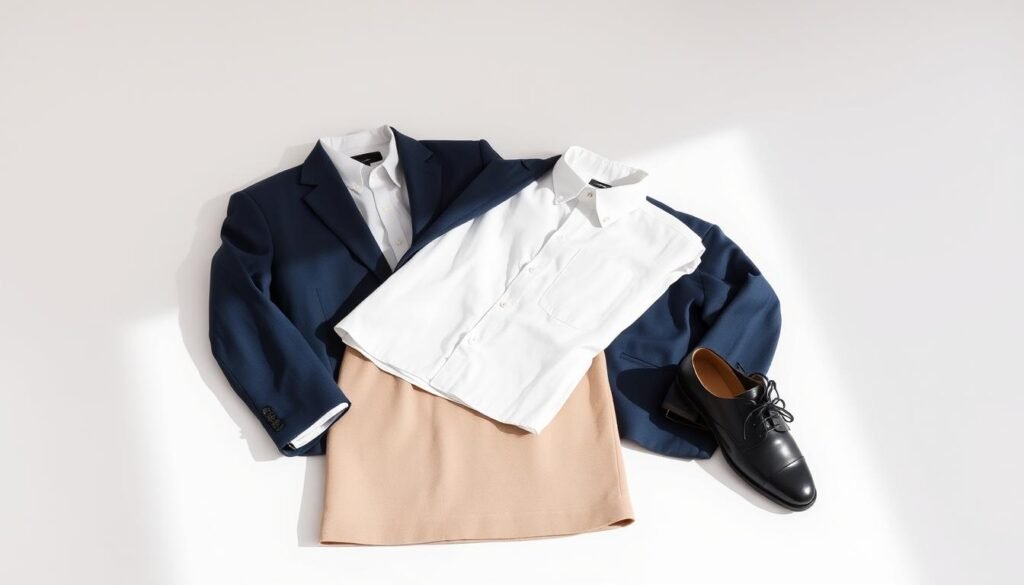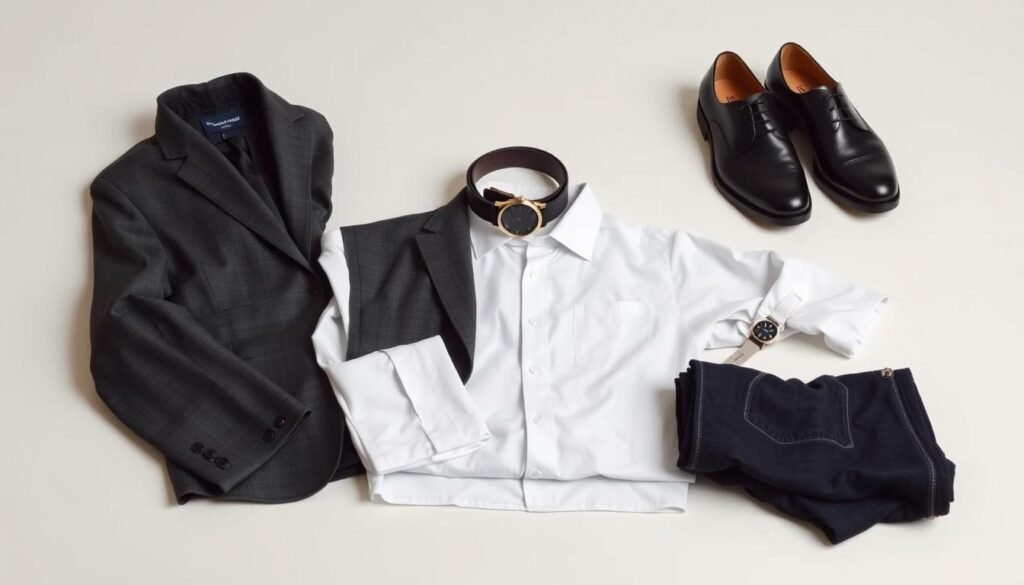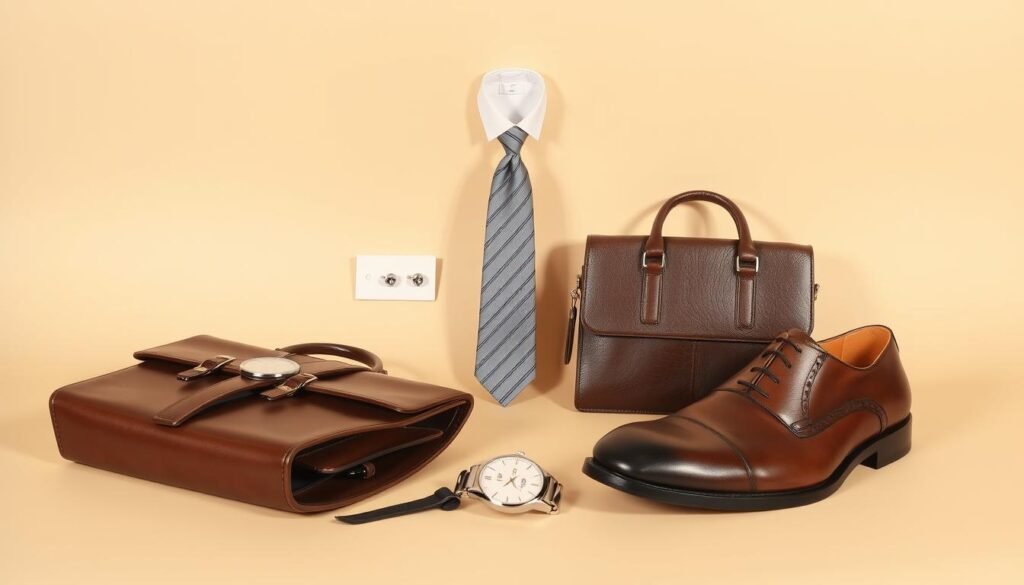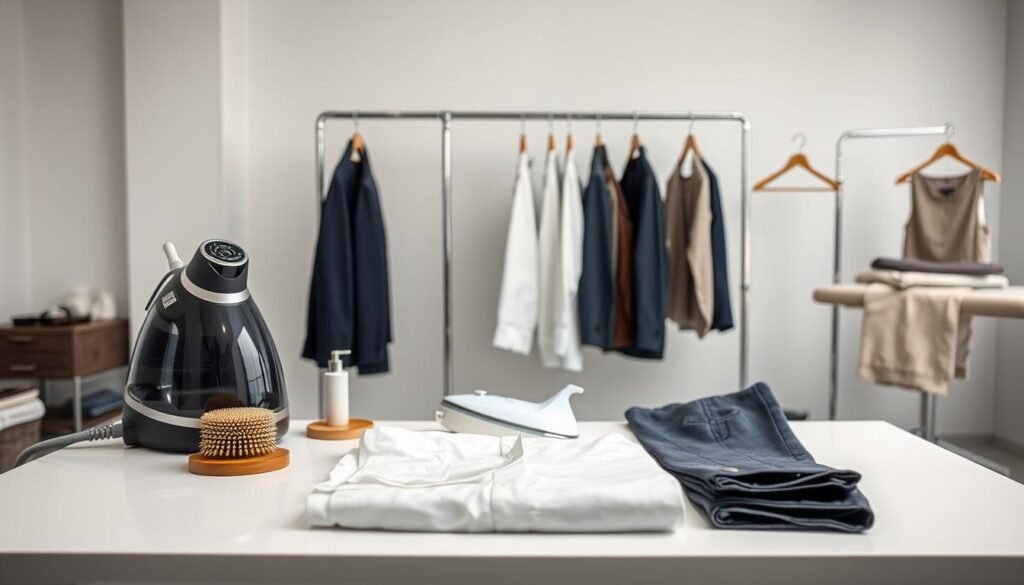“Dress shabbily and they remember the dress; dress impeccably and they remember the woman.” Coco Chanel’s words are as true today as they were when she said them. Your clothes tell people a lot before you even open your mouth.
Studies show that what you wear affects how you feel and think about yourself. Wearing confident outfits can actually make you feel more powerful. This is because our clothes influence our minds, a concept called “enclothed cognition.”
Creating a professional wardrobe isn’t just about keeping up with trends. It’s about showing the world that you’re competent and reliable. When you look polished, others see you as a leader.
There’s a strong link between wearing the right clothes and feeling confident. As you invest in good business clothes, you’ll notice how people see you differently. You’ll also feel more confident in showing your best self every day.
Key Takeaways
- Clothing directly influences your mental state and cognitive performance through “enclothed cognition”
- A well-curated wardrobe communicates competence and reliability to colleagues
- Strategic clothing choices create a positive feedback loop between appearance and self-confidence
- Quality business attire serves as a visual representation of your leadership potentials
- Your appearance sets the tone for workplace interactions before you speak
- Investing in the right pieces transforms both external perceptions and internal mindset
Step 1: Decode Your Workplace Dress Code and Culture
Mastering your company’s dress culture is key to professional wardrobe success. Many professionals make mistakes by assuming all workplaces are the same. Understanding your specific environment saves money and prevents fashion missteps that could harm your reputation.
Your workplace dress code is more than what’s in the handbook. Different industries have different dress codes. For example, finance and law need formal attire, while creative fields prefer business casual.
Remember this rule: it’s always better to be slightly overdressed than underdressed. This shows respect and awareness of your workplace culture.
Research Your Company’s Official Dress Policy
Begin by reviewing your employee handbook and any professional attire guidelines from orientation. Many companies have specific rules for different situations, like client meetings or casual Fridays. Document these official policies as your starting point for wardrobe planning.
Observe Senior Colleagues and Leadership
Watch how successful colleagues and executives dress every day. Notice their color choices, fabric, and styling. These details show the unspoken standards for professional growth in your organization.
Understand Industry-Specific Expectations
Learn about broader industry norms beyond your workplace. Office fashion trends differ greatly between sectors. Tech startups might favor polished casual, while law firms stick to traditional formal. Knowing these differences helps you dress confidently in various situations.
Step 2: Conduct a Complete Wardrobe Assessment

Your journey to professional style starts with checking your closet. This step helps avoid bad choices and guides smart buys. It uncovers hidden favorites and spots outdated items.
Many women feel stuck when sorting their closets. This task isn’t about judging past choices. It’s about building a solid base for your professional look.
Perform a Thorough Closet Audit
Begin your wardrobe audit by taking out all professional clothes. Spread them out on your bed or a clean area. This makes it easier to decide without the clutter.
Try on each piece to check fit and comfort. Ask yourself: “Does this make me feel confident and professional?” If it doesn’t fit right or makes you feel awkward, it’s time to part with it.
Categorize Your Current Professional Pieces
Sort your clothes into three piles: keep, alter, and donate. The “keep” pile has items that fit well and match your work style. The “alter” pile has pieces that need small fixes like hemming.
Organize your “keep” items by type: blazers, pants, skirts, dresses, and accessories. This shows your preferences and highlights your strengths.
Identify Gaps and Immediate Needs
After sorting, see what’s missing from your wardrobe. Common gaps include good blazers, fitting pants, or the right shoes. These workwear tips help you focus on what you really need.
“A well-organized closet is a reflection of a well-organized mind, and both contribute to professional success.”
Keep a record of your findings. It will help you make better shopping choices and ensure your wardrobe supports your career goals.
Step 3: Define Your Personal Professional Style Brand
The best professional wardrobes show off your true style, not just generic business clothes. Your personal style brand shows your values, personality, and career goals. To look confident, first know who you are and how you want to be seen at work.
Think of your style as your professional mark. Just like your handwriting is unique, your fashion should feel natural and true to you. When your clothes match your true self, you’ll seem more confident and in charge.
Determine Your Style Personality
Your style personality is the base of all your fashion choices. Do you like classic, timeless pieces or modern, new designs? Some people look best in structured clothes, while others prefer softer, flowing ones.
Think about your lifestyle and work setting when picking your style. A creative person might like bold patterns and unique textures. Someone in finance might prefer simple, refined looks.
Choose Your Signature Color Palette
A good color plan makes different pieces look great together. Start with three to four neutral colors that look good on you and are the base of your wardrobe.
Add two accent colors that show your personality and match your skin. This way, your professional image stays consistent but you can also express yourself.
Select Flattering Silhouettes for Your Body Type
The right shapes make you look and feel good. Choose cuts that make you feel strong and comfortable, not just follow every trend.
Try different fits to find what works best for you. The goal is to look like yourself but also be respected at work.
Step 4: Build Your Foundation with Essential Wardrobe Pieces

The secret to effortless office fashion is having a few key pieces. These essential wardrobe pieces can be mixed and matched easily. They form the base of your wardrobe, making getting dressed simple.
It’s better to have a few high-quality items than many trendy ones. Your core wardrobe should include pieces that work for both meetings and networking events.
Invest in Quality Suits and Blazers
A good blazer can turn any outfit into professional wear. Start with a classic navy blazer that goes well with skirts and trousers. For more formal events, add a charcoal or grey suit.
Quality clothing like blazers shows you’re competent and in charge. Look for ones with clean lines, quality buttons, and fabrics that stay in shape all day.
Select Versatile Professional Tops
The classic white shirt is a must-have professional basic. It matches every suit and blazer. Add a striped button-down and a subtle micropattern blouse for some flair.
These tops should fit well and not wrinkle easily. Choose fabrics that look good even after many wears and washes.
Choose the Right Pants, Skirts, and Dresses
Tailored trousers in navy, black, and grey are great with blazers and tops. A well-fitted pencil skirt is perfect for meetings.
Have one versatile sheath dress for when you need something simple. Wide-leg pants are a modern choice that’s also professional.
Add Professional Outerwear Options
A good wool coat keeps your office fashion looking sharp outside work. Stick to neutral colors that match your wardrobe.
Try a tweed jacket or velvet blazer for texture and seasonality. These add elegance without being too casual for work.
| Category | Essential Pieces | Color Options | Versatility Score |
|---|---|---|---|
| Blazers | Navy blazer, Grey suit jacket | Navy, Grey, Black | High |
| Tops | White shirt, Striped shirt, Micropattern blouse | White, Blue, Neutral patterns | High |
| Bottoms | Tailored trousers, Pencil skirt, Wide-leg pants | Navy, Black, Grey | Medium-High |
| Outerwear | Wool coat, Tweed jacket | Camel, Navy, Grey | Medium |
Step 5: Master Professional Style Color Coordination
Color coordination makes your professional wardrobe shine. Choosing the right colors creates harmony and boosts your outfit combinations. This strategy makes you look put together every day.
Create a Cohesive Color Strategy
Start with a color palette of three to five colors that go well together. Pick a neutral base like navy, charcoal, or black. Then, add two colors that match across seasons.
Your colors should match your professional style and skin tone. Use these colors for 80% of your clothes. This way, everything looks great together.
Learn Pattern Mixing Rules
Pattern mixing is easy once you know the rules. Start with a big pattern and add a smaller one. Stripes and small florals or geometric prints are a great mix.
Stick to patterns in the same color family for easy color coordination. For example, a navy striped shirt goes well with a navy and white polka dot scarf. This adds interest without being too much.
Build Mix-and-Match Combinations
Layering your clothes makes your wardrobe go further. A single blazer can change five outfits with different tops and bottoms. Scarves, belts, and jewelry add a personal touch to simple outfits.
| Base Piece | Combination Options | Accessory Additions | Occasions |
|---|---|---|---|
| Navy Blazer | White blouse + gray pants | Pearl necklace + leather bag | Client meetings |
| Black Dress | Colorful cardigan + belt | Statement earrings + pumps | Presentations |
| Gray Pants | Patterned top + blazer | Silk scarf + watch | Daily office wear |
| White Shirt | Colored pants + cardigan | Delicate jewelry + flats | Casual Fridays |
“The key to effortless style is having a wardrobe where everything works together. When you master color coordination, getting dressed becomes a joy.”
These workwear tips help you create many stylish outfits with a smaller wardrobe. Focus on pieces that layer well for the best look.
Step 6: Prioritize Quality Over Quantity

Buying fewer, better pieces makes your work clothes last longer. This saves money and keeps you looking sharp. It’s smarter to spend on quality clothing than to fill your closet with cheap stuff.
Identify High-Quality Fabric Indicators
Wool, cotton, and silk are great for work clothes. They’re comfy, last long, and look good. They beat synthetic fabrics in every way.
Blends with synthetic fibers add stretch and durability. These mixes keep clothes looking good while being comfy. Look for labels that say natural fibers first.
Recognize Superior Garment Construction
Good garment construction is all about the details. Check for straight seams, strong points, and quality fasteners. Clothes that are well-made have clean finishes and strong stitches.
Check how patterns line up at seams, like on stripes or plaids. Quality clothes have patterns that match perfectly across seams.
Calculate Cost-Per-Wear Value
Smart investment pieces pay off over time. Divide the cost by how many times you’ll wear it. A $200 blazer worn twice a month for two years costs just $4.17 per wear.
| Item Cost | Wears Per Month | Years of Use | Cost Per Wear |
|---|---|---|---|
| $150 Dress | 4 | 3 | $1.04 |
| $300 Suit | 8 | 5 | $0.63 |
| $80 Blouse | 6 | 2 | $0.56 |
| $250 Coat | 12 | 7 | $0.25 |
Investing in quality is investing in yourself. It’s worth it to avoid buying on impulse.
This way, you build confident outfits that meet your career goals for years.
Step 7: Develop a Strategic Shopping Plan
Creating a clear wardrobe planning roadmap helps avoid expensive mistakes. It makes sure every purchase has multiple uses. A good shopping strategy turns confusing choices into smart decisions that grow your career wardrobe.
Smart shopping needs planning and timing. Without a plan, you might buy things you already have or pieces that don’t fit with what you already own.
Create a Prioritized Shopping List
Begin by looking at your wardrobe to find the biggest gaps in your office fashion. Make a list of what you need, starting with the most important items. Focus on basics like blazers, trousers, and blouses that can be worn in many situations.
Include details like your favorite colors, size, and budget for each item. This helps avoid buying things on impulse that don’t fit your style.
Time Your Purchases with Sales Cycles
Buying at the right time can save a lot of money. End-of-season sales are great for finding deals on coats and suits. Holiday weekends and clearance events also offer good savings on essentials.
Plan to buy big items during these sales. But avoid last-minute shopping for important events or presentations.
Choose Between Online and In-Store Shopping
Online shopping is convenient and has a wide selection. But for structured pieces, trying them on in person is best. Blazers, suits, and tailored items need a good fit.
Use online for basics like shirts and accessories. Save in-store visits for important pieces that need a precise fit.
Build Relationships with Personal Shoppers
Many stylists offer services from closet cleanouts to ongoing styling help. Personal stylists help mix and match pieces to create many outfits. This saves time and money while looking polished.
“A good personal shopper becomes your wardrobe strategist, helping you discover pieces you might never have considered while preventing costly fashion mistakes.”
These experts know your style and can make your wardrobe planning easier.
Step 8: Select Confidence-Boosting Accessories

Quality accessories can make you look more confident. They add polish and personality to your professional style. The right accessories can turn simple outfits into ones that command respect.
Choose Professional Jewelry That Enhances Your Look
Opt for simple, classic jewelry for the best effect. A good watch is both useful and stylish, showing you’re on time and detail-oriented. Small stud earrings or delicate hoops are great for work.
Go for one standout piece at a time. A simple necklace or elegant bracelet can add class without being too much. Steer clear of loud, clanging jewelry that might interrupt.
Invest in Quality Bags and Briefcases
Your bag is both practical and stylish. Pick structured bags in neutral colors like black, brown, or navy. They match many outfits and show you’re organized.
Think about what you need each day when picking your bag. Professional accessories should help you stay organized, not slow you down.
Select Shoes That Command Respect
Get shoes that are comfy and well-made for long days. Classic styles like pumps, loafers, and oxfords are always in style. Stick to neutral colors for versatility.
Add Finishing Touches with Belts and Scarves
Belts and scarves can add a personal touch to your outfits. A good leather belt shapes your look, while a silk scarf adds color and texture. Use them to express yourself subtly and build confidence.
Step 9: Plan for Seasonal Wardrobe Transitions
Smart planning keeps your confident outfits fresh with every weather change. Your professional look shouldn’t fade with temperature shifts. A well-thought-out seasonal wardrobe keeps you looking sharp all year.
It’s all about adapting your core pieces for different weather. This way, you get the most out of your wardrobe and add just the right seasonal touches.
Adapt Your Wardrobe for Spring and Summer
Spring and summer mean lighter fabrics and breathable materials. Ditch heavy wool blazers for cotton or linen ones that keep you cool. Opt for blouses that wick away moisture to stay comfy all day.
Choosing the right colors is key in spring and summer. Go for brighter hues and pastels that match the season’s vibe. Light blues, soft pinks, and crisp whites make confident outfits perfect for warmer weather.
Master Fall and Winter Layering Techniques
Good layering techniques keep you warm and stylish. Start with a good base layer, add a blouse or sweater, and top it off with a blazer or cardigan. This way, you can adjust your look as the day goes on.
Scarves are essential in cold weather. They add warmth, interest, and can elevate simple outfits. Pick scarves in your favorite colors to keep your look consistent.
Invest in Transitional Pieces
Transitional pieces are great for multiple seasons, making your wardrobe go further. A good trench coat works for spring showers and fall weather. Cardigans are perfect for bridging the gap between seasons.
Look for versatile items that fit different temperatures. A silk blouse looks great under a blazer in winter and on its own in summer. These smart picks help you build a cohesive seasonal wardrobe for all year.
Step 10: Establish Proper Garment Care Routines

Keeping your office fashion looking great means knowing how to care for your clothes. Your work clothes are a big investment. They need careful care to stay in good shape and last longer.
Having a regular care routine helps your clothes and saves you money over time. Good clothing maintenance keeps your work clothes looking sharp for many years.
When to Dry Clean vs Home Wash
Always check the care label before you clean your clothes. Suits, blazers, and stiff pieces need dry cleaning to keep their shape and look.
On the other hand, cotton blouses, simple pants, and casual work clothes can usually be washed at home. Use cold water and a mild detergent to avoid color loss and shrinkage.
Storage for Maximum Longevity
Get good hangers that hold the shoulders right. Cedar blocks and lavender sachets keep moths away and make clothes smell nice.
Sort your closet by type and season. Give each piece enough room to avoid wrinkles and keep fabrics in good condition.
Emergency Repairs and Maintenance
Have a basic sewing kit for quick fixes like loose buttons or small tears. Treat stains right away with the right spot cleaner.
Know good tailors and dry cleaners for professional fixes. Proper professional wardrobe care means knowing when to ask for expert help for big repairs or changes.
Step 11: Maximize Your Wardrobe Budget
Creating a polished professional image is easier when you know how to budget and shop smart. Building a budget wardrobe means choosing wisely, not cutting corners on quality or style.
Understanding that professional style is an investment in your career is key. Smart shoppers plan their purchases carefully. This approach is more effective than making quick, impulse buys, no matter the budget.
Set Realistic Financial Goals
First, figure out your annual clothes budget based on your income and career level. Most professionals should spend 3-5% of their gross income on professional clothes.
Divide your budget into quarters to manage expenses better. Start with essential items, then add more variety and style as your budget grows.
Find Quality Pieces at Lower Price Points
Quality doesn’t always mean high prices. Look at fabric, construction, and brand reputation, not just the price. Workwear tips often suggest shopping during sales and at outlets.
Consider buying gently used professional clothes from consignment shops or online. Many high-end items stay in great condition even after a few wears.
Calculate Return on Investment
Check the value of each purchase by dividing the cost by how often you’ll wear it. For example, a $200 blazer worn twice a week for two years costs about $1.92 per wear. That’s a great deal for professional style.
Outlet Shopping Strategies
Go to outlet stores on weekdays for better selection and service. Stick to classic styles, as trendy items may quickly go out of fashion.
End-of-Season Sale Timing
Plan your purchases around sale cycles. Buy winter coats in February, summer blazers in August, and transitional pieces during back-to-school sales.
| Season | Best Sale Months | Items to Target | Discount Range |
|---|---|---|---|
| Winter | January-February | Coats, Sweaters, Boots | 40-70% |
| Spring | April-May | Blazers, Dresses, Flats | 30-50% |
| Summer | July-August | Blouses, Skirts, Sandals | 35-60% |
| Fall | October-November | Suits, Pants, Accessories | 25-45% |
Conclusion
Building a professional wardrobe is more than just picking clothes. It’s about creating a look that boosts your career. Each step in this guide helps you achieve success in your career.
Feeling confident in what you wear can change your life. You might speak up more in meetings or take bigger risks. The right clothes make you feel powerful.
Your style can help you advance in your career. It’s about understanding your workplace and choosing clothes that show who you are. Every choice adds to your professional image.
Start with a few key pieces and grow your wardrobe slowly. Pick items that can be mixed and matched. This way, you can create many outfits with just a few pieces.
Professional style changes as your career does. A good blazer can last for years, fitting different roles. Dressing with confidence shows authority to others.
Investing in professional clothes boosts your confidence and credibility. It opens up new opportunities. Start building your wardrobe today and see how it improves your career.

